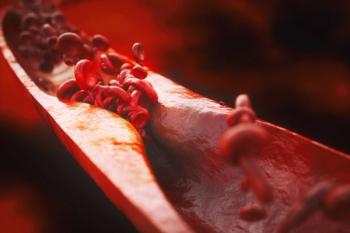
Man With Chest Pain After Cocaine Use
A 53-year-old man presents to the emergency department(ED) with chest pain that started the previous night. Thepain began about 30 minutes after he had smoked marijuanaand inhaled cocaine. He describes the pain as tightnessin the left side of the chest that radiates into theneck; he also has a tingling sensation in both the left sideof the neck and the left arm.
A 53-year-old man presents to the emergency department(ED) with chest pain that started the previous night. Thepain began about 30 minutes after he had smoked marijuanaand inhaled cocaine. He describes the pain as tightnessin the left side of the chest that radiates into theneck; he also has a tingling sensation in both the left sideof the neck and the left arm.
Initially, the pain was accompanied by mild dyspneaand light-headedness but was not associated with palpitations,nausea, or vomiting. After the patient rested, the painsubsided somewhat and he was able to fall asleep for severalhours; however, when he awakened, it was still present.Two sublingual nitroglycerin tablets administered onhis arrival at the ED relieved his chest discomfort.
HISTORY
The patient denies a history of similar episodes. Hehad formerly used cocaine on the weekends, but he insiststhat he has not done so for 18 months as a conditionof his employment.
He has a 10-year history of hypertension and takesnifedipine (sustained-release), 60 mg/d. There is a strongfamily history of coronary disease: his mother died in her50s of an acute myocardial infarction (MI), and his sistersustained an acute MI at about the same age. He usesalcohol on weekends but has never smoked cigarettes.
PHYSICAL EXAMINATION
The patient is anxious, has a headache, and is stillhaving episodes of chest pressure, although they aremuch less intense. Heart rate is 58 beats per minute; respirationrate, 18 breaths per minute; and blood pressure,149/82 mm Hg. Oxygen saturation is 97% on room air.Heart examination reveals regular heart rate and rhythmwithout murmurs or gallops. There are no carotid bruits,and the chest is clear. Peripheral pulses are good; noedema.
LABORATORY AND IMAGING RESULTS
Electrolyte levels, biochemistry panels, and a hemogramare normal. Myoglobin level is 101 ng/mL, andcardiac troponin I level is normal at 0.1 ng/mL. Creatinekinase is 681 U/L (normal is less than 200 U/L), but MBfraction is 1% (normal). An ECG shows a PR interval of0.28 seconds, complete right bundle branch block (RBBB),and Q waves in the initial deflections of leads II, III, andaVF. T waves are upright in II, III, and aVF and inverted inthe precordial leads.
Which of the following is the most appropriate management strategyfor this patient?A. Reassure the patient that the chest pain is cocaine-related and willimprove in the next several hours and discharge him with a supply ofnitroglycerin.
B. Retain the patient in the hospital's 23-hour chest pain observation unitto rule out MI; use nitroglycerin and verapamil as needed.
C. Retain the patient in the hospital's 23-hour chest pain observation unitto rule out MI; use nitroglycerin and propranolol as needed.
D. Retain the patient in the hospital's 23-hour chest pain observation unitto rule out MI, use nitroglycerin and verapamil as needed, and evaluatefor underlying coronary artery disease (CAD).
CORRECT ANSWER: D
Cocaine-related myocardial ischemia and infarctionhave been reported frequently in the literature. The relativerisk of acute MI during the hour after cocaine useexceeds 20, even in persons who are otherwise at lowrisk. This risk is independent of the amount of cocaineingested, the route of administration, and frequencyof use.1
Typically, in patients with cocaine-related myocardialischemia, infarction cannot be ruled out by traditional clinicalfindings, such as pain quality, duration of pain, andrisk factors. However, this patient's age and highly abnormalECG findings may set him apart.
ST-segment elevation is usually associated with cocaine-related ischemia. This ECG change occurs in up to43% of patients who have chest pain following cocaineuse--whether or not they sustain an acute MI.2 This patient'sECG pattern of first-degree heart block and completeRBBB is less typical of cocaine-related myocardialischemia; these ECG findings--particularly completeRBBB--were recently shown to be important markers ofsignificant underlying heart disease.3
Thus, most authorities would agree that a patientsuch as this man is at heightened risk for a subsequentischemic event; in addition to ruling out acute MI andtreating the cocaine-induced ischemia symptomatically, anevaluation for CAD is recommended (choice D).
Choice A does not represent an adequate strategy for2 reasons. First, at least 6% of patients who present withcocaine-induced ischemia exhibit enzymatic evidence ofacute MI2; however, at least half of the patients with acuteMI do not have coronary atherosclerosis. Second, thetime interval during which complications (eg, ventriculararrhythmias, congestive heart failure, or death) are likelyto occur is about 12 hours from initial presentation. Thus,the patient should be under medical observation for atleast that long.
Cocaine causes marked vasoconstriction of coronaryarteries, primarily by stimulation of α-adrenergic receptors.4 β-Adrenergic antagonists, such as propranolol, havebeen shown to potentiate this vasoconstriction; thus, thesedrugs are contraindicated in cocaine-related chest pain.5The use of β-blockers in a patient with the ECG abnormalitiesseen here (ie, bifascicular block--complete RBBBand first-degree atrioventricular block) is also problematic.Thus, choice C is incorrect.
Choice B, which includes observation of the patientfor an adequate period to exclude acute MI and the use of2 agents (nitroglycerin and verapamil) that are well-knownto reverse cocaine-induced vasoconstriction of coronaryarteries and hypertension, is a sound diagnostic and therapeuticstrategy for many patients with cocaine-relatedchest pain. However, this patient's ECG and, to a lesserextent, his age suggest a substantial risk of underlyingCAD. Thus, in this case it is necessary to be more aggressivediagnostically. This patient would be a good candidatefor further study regardless of his ischemic symptoms.
Outcome of this case. Acute MI was excluded bystandard criteria. A stress thallium study revealed a fixeddefect inferiorly and a reversible defect laterally. The patientwas referred for cardiac catheterization for definitivediagnosis and therapy.
Newsletter
Enhance your clinical practice with the Patient Care newsletter, offering the latest evidence-based guidelines, diagnostic insights, and treatment strategies for primary care physicians.



